Home to Machu Picchu (one of the new seven wonders of the world), the Amazon rainforest, Andes mountains and vast stretches of beaches, Peru plays host to a diverse and magnificent range of landscapes and ecosystems.
Because of this, weather conditions vary wildly across the country, which is why working out the best time to visit Peru and Machu Picchu can feel complicated.
I’ve identified key places you’ve probably got on your itinerary and outlined what weather you can expect and when, plus other things to consider including how busy they’re likely to be with other tourists. Hate to experience a destination alongside all the other crowds?
No worries: I’ve indicated high season for tourists and the months when you’ll find not only fewer visitors but cheaper prices, too.
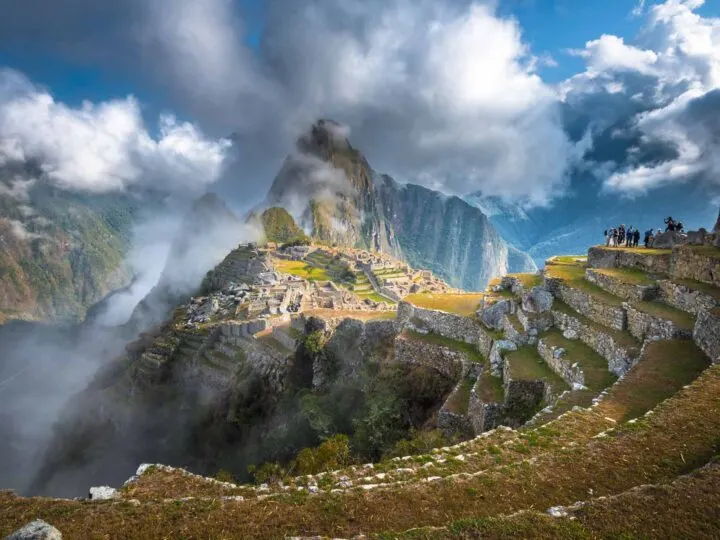
FAQs about the best time to visit Peru
Peru month-by-month
- January: Soak up the sunshine along the coast north of Lima, when the weather’s hot, although prices – and crowds – are at their highest. Alternatively, if you don’t mind rain showers here and then, head to Peru’s highland areas for trekking and sightseeing without the crowds; these are the wettest months to travel in Peru, however.
- February: It’s carnival season in Peru, so head to Cajamarca for one of the country’s biggest and most exuberant carnival celebrations, or to Puno for a traditional carnival with dancing and folkloric music. Big swells reaching the coast marks this month as a great time to take your board and surf Peru’s waves in Mancora, Huanchaco and locations around Lima. Beware: the Inca Trail is closed for maintenance.
- March: The best month to visit Peru’s coast, March is when you can expect dry weather and clear skies along the coast and inland towards Trujillo, Arequipa and Cajamarca. The tail end of the rainy season in the highlands is also the perfect time to visit Chachapoyas to see the Gocta and Yumbilla waterfalls at their most full and spectacular.
- April: The Andes are lush and green, making it a great time to explore mountain regions of Peru, including Lake Titicaca and Cusco – although rain showers are still likely during this period. Depending on the year, Easter may fall in March or April; visit to see the traditional and colourful carnival celebrations kick off all over Peru.
- May: With the dry season kicking off, May is an excellent month for a trekking holiday, with spring-like temperatures in Cusco, Arequipa and Huaraz. Fewer trekkers along the Inca Trail and other routes to Machu Picchu and Choquequirao make this one of the best months to visit Peru’s most famous archaeological site.
- June: Trekking season is in full force, with June known for its cooler temperatures and clear skies, as well as the Inti Raymi festival, held to celebrate the Winter Solstice in Cusco. To escape the crowds in Cusco, head instead to the mountains of Huaraz for high-elevation trekking adventures. Rain begins to ease in the jungle, making Puerto Maldonado, Iquitos and other parts of the Amazon attractive during this month.
- July: Peak season in the Andes makes the visit to Machu Picchu extremely popular. Alternatively, head to Chachapoyas to explore Kuélap and the north’s other spellbinding archaeological sites.
- August: August is the coldest and driest month in the entire year, and another popular month to trek in highland areas such as Arequipa, Cusco, Lake Titicaca and Huaraz. With low rainfall and low water levels, the Amazon Basin is ideal during this month, with access to jungle trails and decent chances of sighting wildlife.
- September: As the high season comes to an end, September is the perfect time to visit the highlands. The Sacred Valley, Cusco and the main treks to Machu Picchu, such as the Salkantay and the Inca trail are quieter than in the previous months, while dry weather makes hiking in the Cordillera Blanca near Huaraz similarly possible. Dry weather continues in the Amazon, with fewer mosquitos and warmer temperatures, too.
- October: Head north of Lima to Trujillo, Huanchaco, Cajamarca and the northern beaches where temperatures are still pleasant but prices and crowds are lower than during the peak tourist season of December through January. Alternatively, make the most of the final month of dry weather before the rainy season commences by trekking the Inca Trail to Machu Picchu.
- November: Head to Puno on November 5th to see Incan leaders Manco Capac and Mama Ocllo emerge from Lake Titicaca and lay claim to the new lands of their empire. The Amazon Basin is empty of tourists but full of wildlife during this month, making Iquitos and Puerto Maldonado a good bet.
- December: Peru’s coasts are starting to warm – and fill up with tourists – for the festive season, so avoid these regions if you want a quieter trip. As the rainy season begins in the highlands and interior, this month is a great one to see the Amazon by boat. The rivers have swollen due to rain and offer the best opportunities for seeing wildlife.
Planning Your Trip to Peru?
Save time, stress & money with a customized travel itinerary planned for you by a Peru expert
Understanding Peru’s weather: the dry season and wet season
Due to its close proximity to the equator, Peru is a tropical country with a wet season and a dry season. The best time to visit is complicated by both high rainfall and the regional differences in weather experienced across the country.
Peru can be divided into three distinct regions: the desert coast, Andean highlands and the Amazon rainforest.
Both the highlands (Cusco, Arequipa, Huaraz, Puno) and the rainforest receive a lot of rain between December and March, in a period known as the wet season, where temperatures are at their warmest, and which roughly correlates with the southern hemisphere’s summer.
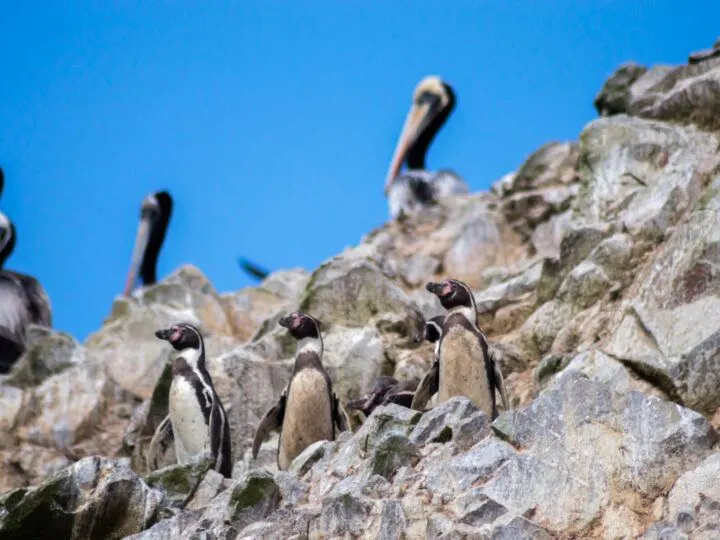
From May to September, these regions experience the dry season, as well as cooler temperatures. These months match with the southern hemisphere’s winter.
The months of April, October and November are viewed as the shoulder seasons and the weather can be a little unpredictable, with a mix of rain and sun.
The coast – home to Lima and towns such as Nazca, Lima, Trujillo, Chiclayo and Mancora – tends to be dry all year round, with much hotter temperatures from December through March.
As a result, it’s likely that your Peru itinerary will combine various different destinations and climates.
Machu Picchu and the Inca Trail
Machu Picchu, the site of one of the greatest South American archeological sites, is found in the Cordillera de Vilcabamba. It’s open every day of the year, however, some treks around this area are closed in the rainy season.
Machu Picchu and the Inca Trail during the rainy season: from December to March
During the rainy season, showers are common in the afternoon and temperatures range from 12-24°C (54-75°F). While the archeological site is open during these months, it’s worth noting that February is the wettest month of the year in the Andes.
Want to support a sustainable, Peruvian-run company when you hike the Inca trail? Alpaca Expeditions are my go-to suggestion thanks to their incredible work supporting indigenous communities across the Cusco region and the exceptionally high-quality nature of their tours. They’re also now offering Worldly Adventurer readers a 5% discount on all of their hikes – just use the code Worldly Adventurer when you enquire! Check out their Inca trail tour.
Because of this, the Inca Trail is closed both due to unsafe weather conditions and for repairs to take place along the path. However, alternative treks to Machu Picchu such as the Salkantay, are still open.
Visiting during wet season? You’ll want to wear a waterproof outer shell as well as plenty of layers due to the unpredictable temperatures and weather conditions.
Machu Picchu and the Inca Trail during the dry season: from May to September
The dry season is the best time to visit Machu Picchu, as trail conditions are easier and you’re also less likely to have an overcast day when you reach the site. Temperatures range between 17°C (62°F) and 19°C (66°F) and, because the wet season has nourished the ground, the landscapes are vibrant green.
Most people tend to visit the Inca city in the mornings, so if you’re wanting less of a crowd, opt to visit in the afternoon!
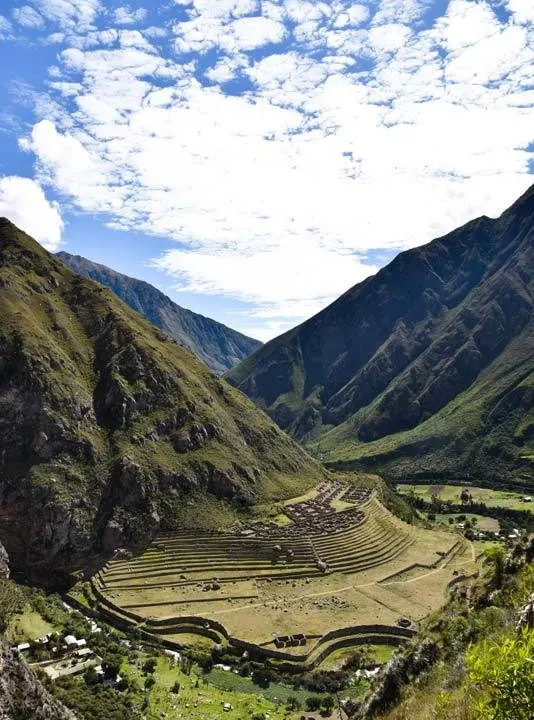
June and July are some of the best months to hike the Inca trail and visit Machu Picchu because of the settled, dry weather. However, these months are when the region sees the most crowds, so consider the shoulder months of May and September for a quieter trek, as crowds are a fraction of what they are in June and July.
Be aware that nights are cold and temperatures can drop below freezing, so if you’re hiking or staying over in Aguas Calientes, you’ll want to bring plenty of warm layers.
Curious about the cost of visiting this incredible archaeological site? We’ve compiled a guide to how much it costs to go to Machu Picchu.
Cusco and the Sacred Valley
Situated at 3,399 meters above sea level, Cusco has mild year-round temperatures, with heavy rainfall during the rainy season and more settled – but still cool – weather during the dry season.
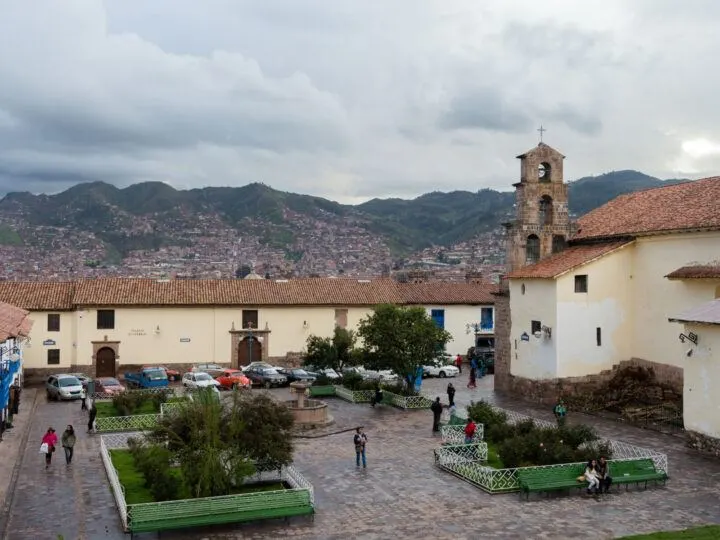
Visiting Cusco during the dry season: from May to September
The former capital of the Inca Empire, Cusco is a city located high up in the Andes. Like the Inca Trail, the dry season, especially June to August, is considered the best time to travel here.
Night-time temperatures are much lower in the dry season and many cheaper hotels don’t tend to have heating. As a result, you’ll want to bring thick clothing for overnight (and be prepared to bed down with plenty of blankets).
This is also the high season for travel, which can add to the cost of staying in Cusco. Learn more in our guide to the cost of visiting Peru.
The Sacred Valley, due to being just 50 km away from Cusco, tends to have the same weather patterns as the city. If you want to visit the Sacred Valley’s archaeological sites or stay overnight here, it’s best to travel between the months of April and October and there are some great hotels and guesthouses in the Sacred Valley for all budgets.
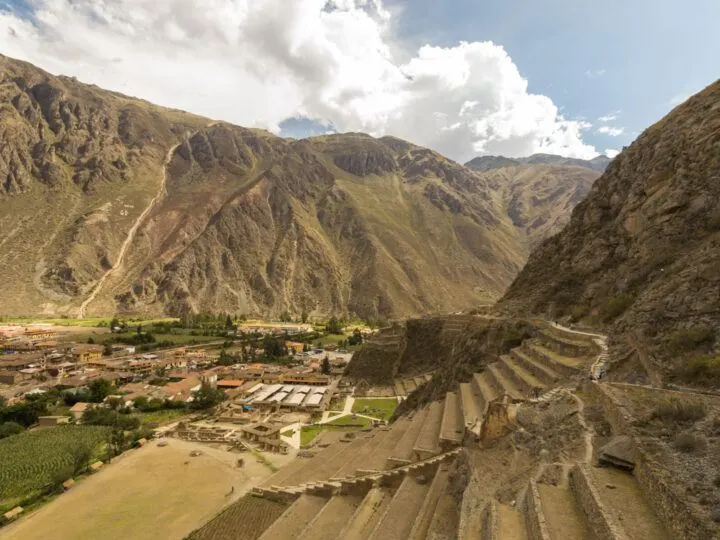
Another reason to visit Cusco and the Sacred Valley during the dry season is to experience The Inti Raymi festival, an ancient Inca religious celebration in honor of Inti, the Inca god of the sun
It takes place in Cusco every June 24th and sees over 25,000 people gather to celebrate with parades as actors pretending to be the Inca are carried up to the Sacsayhuamán archaeological site above the city.
Visiting Cusco during the rainy season: from December to March
Visiting Cusco in the rainy season isn’t the end of the world, as long as you’re prepared to get a little wet. Weather can be unpredictable, but there’s no guarantee that it’ll rain all day, every day.
In actual fact, this can be a good time to visit, as the mountains surrounding the city are verdant and the city is quieter without the hordes of tourists that flock here during the dry season.
Lake Titicaca and Puno
Lake Titicaca is the largest lake in South America and is located on the border between Peru and Bolivia in the Andes, with Puno lying on its shores.
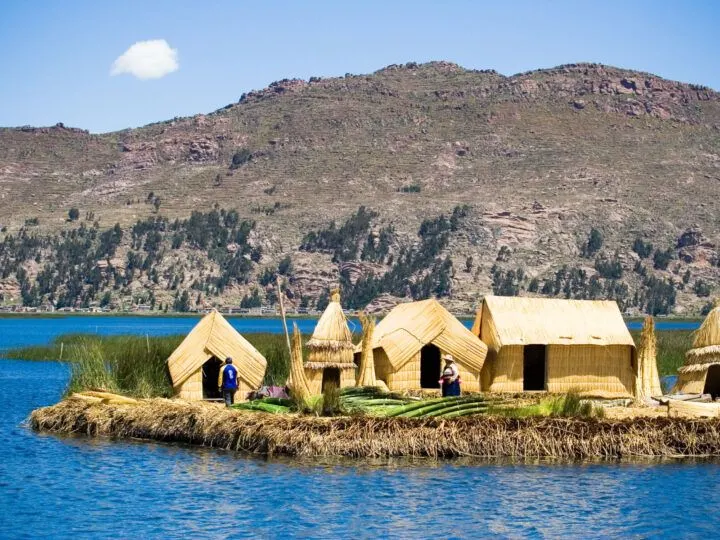
As boat tours to the floating Uros Islands are some of the main reasons to visit the region, it’s best to explore Lake Titicaca and Puno in the drier months of the year. January tends to see the most rainfall with July being the driest. Temperatures are relatively cool all year round, however, nights in the dry season drop below freezing due to the fact that the lake is located at 3,812 meters above sea level.
April to October is when Lake Titicaca sees the most tourists, who flock to the region for blue skies and the best conditions for exploring the lake.
If you can’t visit during this period, plan to arrive in February when Puno celebrates La Candelaria. The country’s biggest cultural event, it sees tens of thousands of musicians and dancers paying homage to the Virgin of Candlemas, the town’s patron saint.
Arequipa and Colca Canyon
Peru’s white city, Arequipa, is an extremely popular location for tourists to spend a few days on their way to hike or merely admire the Colca Canyon, the second deepest canyon in the world. If you want to visit Arequipa and the Colca Canyon for the hiking trails, condor sightings, or hot springs then, as with other places found in the Andes, they are best visited in the dry season.
Situated at 2,335 meters above sea level and surrounded by volcanoes, Arequipa experiences relatively mild day temperatures year-round, which hover around 21°C (70°F).
At night, temperatures can drop below freezing, so bring plenty of warm clothing, particularly if you plan on spending your evenings enjoying the outdoor terraces of the city’s bars and restaurants – one of the many unmissable things to do on a visit to Arequipa.
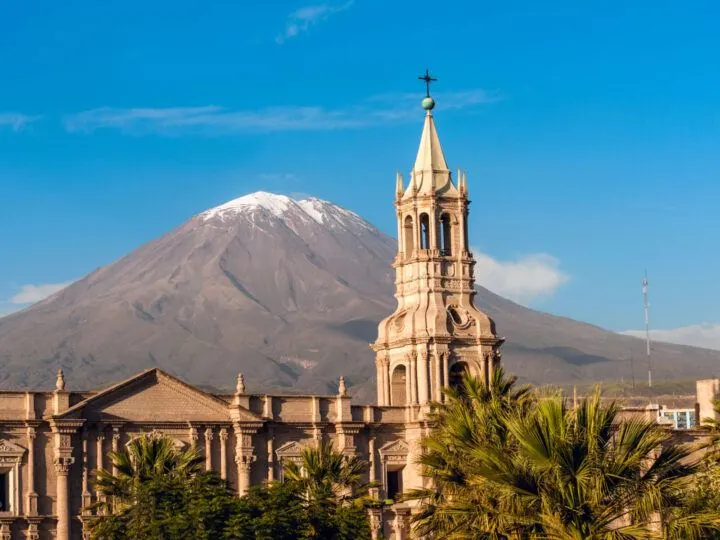
Chivay, a small town in the Colca Valley and a gateway to the Colca Canyon, holds a traditional carnival in the rainiest month of the year, February, making this a good time to visit if you want to learn about the culture and traditions of the people of the Peruvian Andes.
Puerto Maldonado, Iquitos and the Amazon Basin
Unlike the Andes, the Amazon Rainforest is hot, rainy, and humid for most of the year. The dry and shoulder seasons have shorter showers whereas, during the wet season, you can expect heavy rainfall.
If you want to trek on foot through the jungle from Puerto Maldonado or Iquitos, then the dry season is the best time to visit these areas due to the lower chance of rain and better trekking conditions.
You’ll also experience fewer mosquitos making your trip much more pleasant and, because the trails aren’t as muddy, there is a lesser chance of trips and activities being postponed during these months.
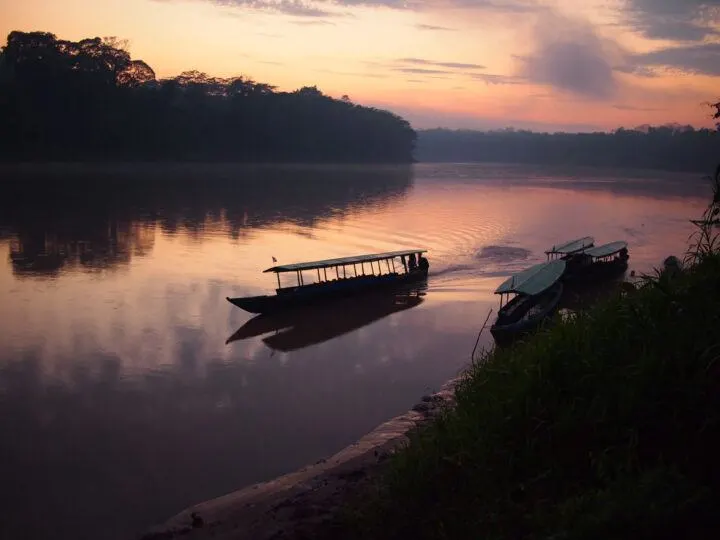
Between September and November, you can also expect fewer crowds than in the peak months of June through August, as well as fantastic conditions for land explorations.
If you have plans of exploring the Amazon by boat, visiting during the wet season is advised. The rainfall causes rivers to swell, making them easier to navigate and allowing you to get in closer contact with wildlife.
Iquitos, another popular gateway into the Amazon jungle in Peru, is popular from June through to October because of the drier, warmer weather. The festival of San Juan also happens from June 22nd to June 25th when locals pack food and drink and head to the river banks to celebrate.
Huaraz and the Central Highlands
Located in the Andean Highlands, Huaraz is Peru’s hiking hub and is the perfect location for 5,000-metre-plus trekking adventures in its magnificent mountainous landscapes.
Huaraz is a great destination if you’re into outdoor sports such as hiking, rock climbing, snowboarding, and mountain biking, with Huascarán National Park and the whole Cordillera Blanca mountain range offering incredible adventure opportunities – they’re the highest range in the tropical world, after all.
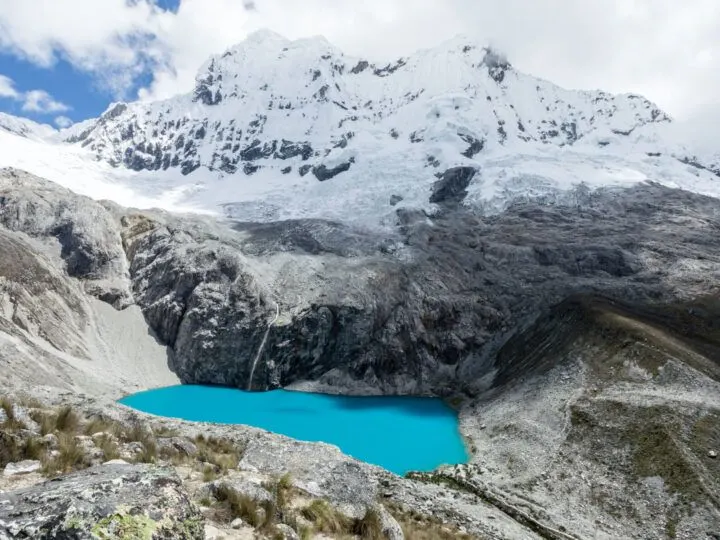
The best time to visit is April through November when the weather is dry and, while temperatures are cooler than the rest of the year, the conditions are best for mountaineering.
If you’re coming to Huaraz to snowboard, the high season is July to September during Peru’s winter (dry season).
Many festivals take place during the dry season which are Hauraz’s busiest months. You can expect to see fireworks, bands, and even bullfights during these festivals.
Lima
The largest city and capital of Peru, Lima is situated along the Pacific coast. The coast of Peru is considered to have a desert climate, with the weather conditions extremely different from the central and eastern parts of the country.
It rarely rains in Lima and the best times to visit are from December to April, during Peru’s summer. The temperatures are hot and humid, making it the perfect time to travel if you want a beach holiday. Sunsets are also known for being extremely colorful at this time of the year.
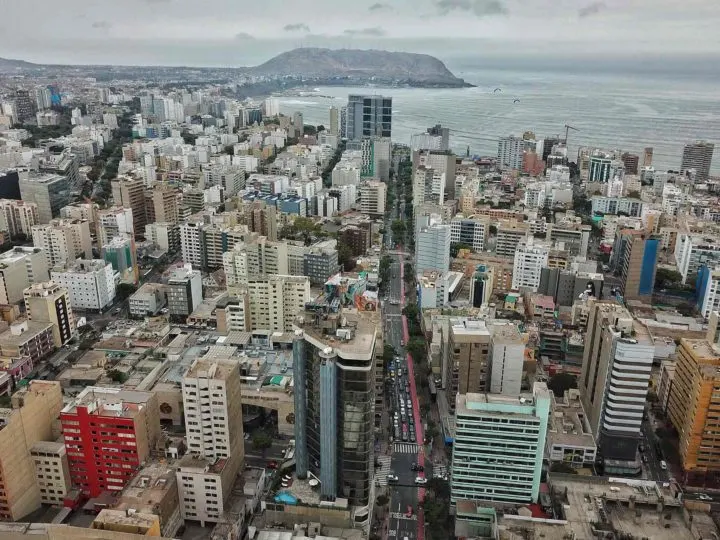
Due to the Humboldt Current, the water temperature in Lima is never warm but can become acceptable for swimming in the months of January, February, and March.
From May to September, Lima is often blanketed with fog, while slightly milder temperatures and the possibility of rain make this a less attractive time to visit. However, for surfers, swells are biggest during the winter months in Lima, making this the ideal period for catching some waves.
There are a few festivals that happen during the winter months, including the Fiestas Patrias (Peruvian Independence Day) on the 28th of July, where large military parades take place.
August 30th sees the celebration of Fiesta de Santa Rosa where religious processions take place celebrating Saint Rosa.
At the beginning of September, the ten-day Mistura food festival is held. This huge market showcasing some of Peru’s finest foods is considered the largest food event in South America.
The Northern Coast (North of Lima to Ecuador)
From November to March, the beaches north of Lima are extremely warm with temperatures averaging between 30°C and 40°C (86-104°F). These summer months are also the peak surf season, with sunny weather and a decent northern swell.
The sea temperatures in the northern parts of the coast are warmer than in Lima, making them better swimming destinations if you’re looking for a beach break. Mancora is one of the most popular beaches to visit on the northern coast and is most popular during the dry season.
July to November, however, are considered great months for activities such as catching glimpses of humpback whales that are migrating north for calving season.
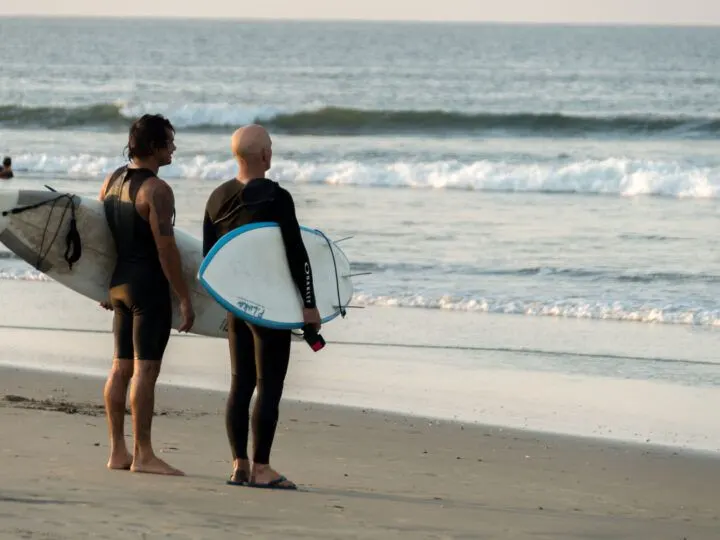
Inland, the cities of Cajamarca and Chachapoyas see the same weather conditions as the highland regions in the south, with the driest weather falling between April and November.
Both are easy to visit throughout the year, although the shoulder months of April and May and September and October see pleasant weather and fewer tourists.
As expected, Mancora and the northern beaches see an influx of visitors during the end of December to celebrate the New Year. In Cajamarca, their annual carnival is held in late February and brings flocks of people to the city for traditional dancing and celebrations.
The Southern Coast (South of Lima to Chile)
Home to the Nazca Lines, the Ballestas Islands, and Peru’s pisco-growing regions, the coast of southern Peru has a similar climate to the northern coast.
It’s also best explored between November and April, when temperatures are warmest, however, like all parts of the coast, there is rarely any rainfall, which makes it a perfect year-round destination.
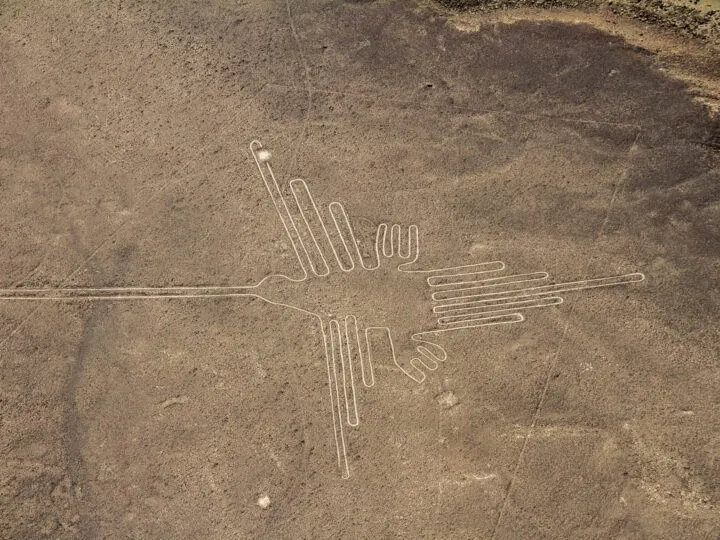
If planning on taking a flight over the Nazca Lines, wind conditions are generally calm throughout the year, making these tours possible year-round. However, November through April is your best bet for avoiding potential cancellations due to rainfall or cloudy skies. Opt for a morning flight for the least turbulence and the clearest views.
The Ballestas Islands are replete with wildlife year-round, however, January through March is when sea lions give birth to their young, making this a good time to see the new pups.
